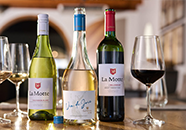
The wine is a blend of 90% Sauvignon Blanc and 10% Semillon. The Sauvignon Blanc originates from vineyards in the Elgin, Bot River, Elim and Napier areas and the Semillon from the Bot River area alone. These vineyards fall under the new classification Origin Cape South Coast and are of the most southerly situated vineyards in Africa.
Good winter rains and cold resulted in even, slightly later budding. Warmer conditions later, with ample rain towards the end of November and during early January caused lush growth, which promoted favourable conditions for disease. Fortunately, regular winds during January helped to control botrytis. Yield was good and healthy where harvesting was early. Acids were more unstable, while pH was high.
Each vineyard grows in its own macro climate and different clones are represented. All the vineyards are trellised and managed to keep leaf coverage and yield in perfect balance. Soils are mostly of a shale origin, with medium potential. Due to cool conditions, low fertility is maintained, with yield being approximately 6 tonnes/ha. The Elgin area has deeper soils with a higher potential and a yield of approximately 8 tonnes/ha.
Grapes were harvested at between 20 and 22 degrees Balling. Skin contact of approximately 16 hours was allowed. Fermentation was at approximately 14 degrees Celsius. The wines were removed from the heavier lees, but left on the fine lees for five months. Then blending followed. The wine was bottled at the end of July and 10 000 cartons (6 x 750 ml) will be released.
Vineyards in the cool, emerging areas near the southernmost tip of Africa are combined to produce a wine of Origin Cape South Coast. The wine is thriol-driven and shows, especially, citrus and grenadilla flavours. Green pepper flavours are in the background. Very elegant palate with a mineral finish
Alcohol 12,77% Vol
Residual sugar 2,3 g/l
Total acid 6,1 g/l
pH 3,44












